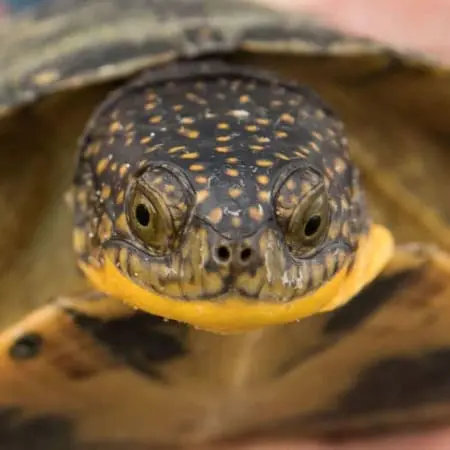(Emydoidea blandingii) (blanding’s turtle for sale)
Blanding’s turtles for sale are some of the most amazing semi aquatic turtles for sale from us here at Tortoise Town. We only carry captive bred blanding’s turtles for sale including baby blanding’s turtle for sale, well started 6 month old blanding’s turtles for sale, and juvenile yearling blanding’s turtle for sale. We always will recommend the well started baby blanding’s turtle for sale over the more fragile blanding’s turtle hatchling for sale.
Living up to 80 years and reaching a shell length of up to nine inches, this omnivorous species consumes fish, plants, flowers, frogs, berries, earthworms, and more. Color and Size: A dark green to black carapace mottled with yellow spots, rays and flecks at a length of between 7 and 10 inches is typical. The carapace is also oval and features no flaring of the marginal scutes except in some males.
Known as “the turtle that smiles”, the Blanding’s turtle occurs in the northern most portions of the United States but also in Ontario and Nova Scotia. Disjunct populations in New York and New England are found while the main concentration of these turtles is located around the Great Lakes region.
Like all of our tortoises for sale and turtles for sale online, our blanding’s turtles for sale come with our full live arrival and 7 day health guarantee. With a biologist ON SITE, shop with confidence that TortoiseTown is your source for healthy, happy and well started turtles for sale and tortoises for sale, shipped overnight for early morning arrival in heated / cooled insulated containers via FedEx Overnight.
More information:
The yellow plastron with a black blotch on each plate has a single hinge. This turtle is unique in having an extremely long neck much like a snake-neck turtle. They differ in that the head is not carried to the side but is held straight forward like other North American emydids. The head is somewhat flat with large “frog-like” eyes and the jaws reveal a big smile. The chin and throat are a bright yellow which can be spotted from a distance. The rest of the head and neck are dark with few if any markings. Sometimes, yellow flecks are found on the top of the head like on the carapace. The front limbs are dark with yellow scales and are equipped with large, sharp claws. Both the front and rear feet resemble those found on the box turtle which can sometimes confuse humans trying to identify them. The box turtle-like limbs and the hinged plastron make the Blanding’s turtle similar in appearance. Blanding’s however, cannot fully close up like the box turtle. Males exhibit a concave plastron, a longer, thicker tail a slight trapezoidal shape at times and may have a larger, broader head than females.
Emydoidea are found in highly vegetated, shallow water but are sometimes found in deep lakes. Farm ponds, wet meadows, marshes, bogs and even slow moving streams are inhabited. These turtles also move between bodies of water especially in the spring after hibernation, during nesting season and before hibernation in autumn. They are active from March until October with egg laying taking place in June. They hibernate under thick ice from November until March or April depending on the area. They are so cold tolerant that they can be seen slowly moving under the ice during the coldest of months. Information provided with consent from Chris Leone of GardenStateTortoise, LLC.
- Display 15 Products per page

